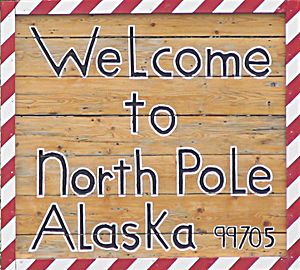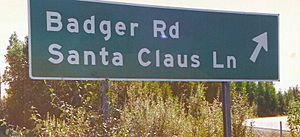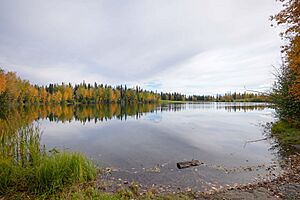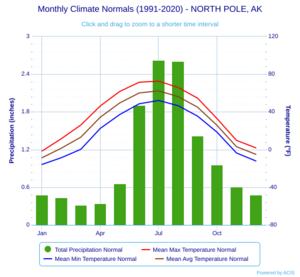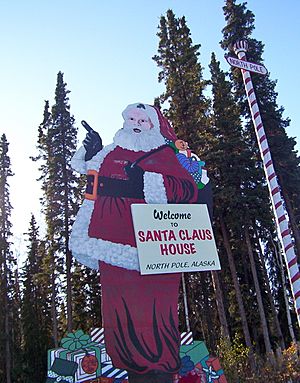North Pole, Alaska facts for kids
Quick facts for kids
North Pole, Alaska
|
||
|---|---|---|
| City of North Pole | ||
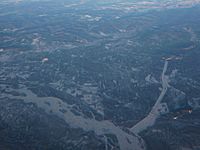
A January 2011 aerial view of North Pole, looking north, with the Tanana River to the southwest of it
|
||
|
||
| Motto(s):
"Where the Spirit of Christmas Lives Year Round!"
|
||
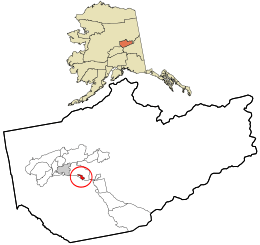
Location within Fairbanks North Star Borough and the U.S. state of Alaska
|
||
| Country | United States | |
| State | Alaska | |
| Borough | Fairbanks North Star | |
| Incorporated | January 15, 1953 | |
| Government | ||
| • Type | Home rule city | |
| Area | ||
| • Total | 4.10 sq mi (10.62 km2) | |
| • Land | 4.08 sq mi (10.58 km2) | |
| • Water | 0.01 sq mi (0.04 km2) | |
| Elevation | 482 ft (147 m) | |
| Population
(2020)
|
||
| • Total | 2,243 | |
| • Density | 549.08/sq mi (212.00/km2) | |
| Time zone | UTC-9 (Alaska (AKST)) | |
| • Summer (DST) | UTC-8 (AKDT) | |
| ZIP code |
99705
|
|
| Area code | 907 | |
| FIPS code | 02-55910 | |
| GNIS feature ID | 1407230 | |
North Pole is a small city in the Fairbanks North Star Borough, Alaska, United States. It became a city in 1953. North Pole is part of the larger Fairbanks area.
According to the 2020 United States census, 2,243 people live in the city. This was an increase from 2,117 people in 2010. Even though it's called North Pole, the city is actually about 1,700 miles (2,700 km) south of Earth's true North Pole. It is also about 125 miles (201 km) south of the Arctic Circle.
Contents
Discovering North Pole, Alaska
North Pole is a popular place for tourists in the summer. Many people visit while traveling to or from Fairbanks and other parts of Alaska. The city is located right on the Richardson Highway.
In the past, North Pole had two oil refineries. These were a big part of the town's economy, along with tourism. However, they closed because of pollution in the groundwater. The larger refinery made a lot of jet fuel for the Ted Stevens Anchorage International Airport. Trains carrying oil often traveled through the city.
Santa Claus House and Christmas Spirit
The most famous attraction in North Pole is the Santa Claus House. It started as a trading post long ago and is now a large gift shop. Outside, you can see the world's largest fiberglass statue of Santa Claus. There are also some friendly reindeer nearby.
Every year before Christmas, the USPS post office in North Pole gets many letters for Santa. Thousands more letters arrive from people who want the special North Pole postmark on their Christmas cards. The city even uses the ZIP code 99705 as Santa's own ZIP code. A special program also helps reply to letters sent to "1 Santa Claus Lane."
Many streets in North Pole have Christmas-themed names. These include Santa Claus Lane, St. Nicholas Drive, Snowman Lane, and Kris Kringle Drive. The street lights look like candy canes. Many local businesses also have festive decorations. The city's fire trucks and ambulances are red, and the police cars are green and white. North Pole also has a women's Roller Derby team called the North Pole Babes in Toyland. Their team members have fun Christmas-themed names.
Homes in North Pole are generally affordable compared to other parts of Alaska.
North Pole's Past
In the 1940s and 1950s, the area south of Fairbanks along the Richardson Highway had many farms and land plots. Bon V. and Bernice Davis settled the central area of North Pole in 1944. Their son, T. Neil Davis, later wrote a book about life on a homestead.
The Alaska Railroad built a train stop on the Davis land. They called it Davis, and this name was used for the small settlement for a while. In 1952, a company bought the Davis land. They divided it into smaller plots and renamed the area North Pole. They hoped this name would attract a toy company.
The City of North Pole officially became a city on January 15, 1953. James Ford became the first mayor. Conrad B. Miller, an early city council member, opened a trading post in 1952. This business grew into the famous Santa Claus House. It also served as North Pole's first post office for nearly 20 years.
The town's economy relied on these businesses until the 1970s. That's when the Richardson Highway was updated, bypassing the old downtown area. In 1977, the Earth Resources refinery started operating. It connected to the Trans-Alaska Pipeline System with smaller pipelines. After the refinery was built, the North Pole Plaza shopping mall was constructed. A high school and new neighborhoods also appeared.
In the early 1990s, new road connections were built along the Richardson Highway. These improvements helped reduce traffic problems.
The city government has sometimes faced disagreements. For example, a past mayor, Jeff Jacobson, worked full-time as both mayor and a teacher. In 2004, Mayor Jacobson sent a letter and a lump of coal to a U.S. Senator. He did this to show his disagreement about what he felt was wasteful spending on a recreation project.
The current mayor of North Pole is Larry Terch. The city council has six members. They serve three-year terms, and elections are held every October.
North Pole's Location and Environment
North Pole is about 13 miles (21 km) southeast of Fairbanks. It is located on the Richardson Highway. The city covers an area of about 4.2 square miles (10.9 km²). Most of this is land, with a small amount of water.
The city is near the Tanana River. However, it's not easy to reach the river because of many protective walls. Beaver Springs Slough, a small stream, flows through the city. It then joins Chena Slough.
North Pole is the main city for the ZIP Code 99705. This area includes land between Fort Wainwright and Eielson Air Force Base. It also stretches between the Chena River and the Tanana River.
North Pole's Climate
North Pole has a subarctic climate. This means it has very cold, long winters and short, mild summers. Temperatures are greatly affected by how much sunlight the area receives.
Because North Pole is far from the ocean and surrounded by mountains, its temperatures change a lot between seasons. Winters can be extremely cold, often dropping many degrees below zero Fahrenheit. Summers can be warm, with temperatures sometimes reaching the 70s, 80s, or even 90s Fahrenheit.
The coldest temperature ever recorded was -67°F (-55°C) in January 1975. The warmest was 95°F (35°C) in June 1969 and June 1983. North Pole experiences many days each year where nighttime temperatures are below freezing.
| Climate data for North Pole, Alaska (1991–2020 normals, extremes 1968–present) | |||||||||||||
|---|---|---|---|---|---|---|---|---|---|---|---|---|---|
| Month | Jan | Feb | Mar | Apr | May | Jun | Jul | Aug | Sep | Oct | Nov | Dec | Year |
| Record high °F (°C) | 55 (13) |
49 (9) |
60 (16) |
76 (24) |
86 (30) |
95 (35) |
91 (33) |
92 (33) |
77 (25) |
74 (23) |
50 (10) |
47 (8) |
95 (35) |
| Mean maximum °F (°C) | 29.3 (−1.5) |
35.6 (2.0) |
47.5 (8.6) |
62.2 (16.8) |
76.3 (24.6) |
84.8 (29.3) |
85.0 (29.4) |
80.3 (26.8) |
69.1 (20.6) |
54.5 (12.5) |
31.0 (−0.6) |
29.2 (−1.6) |
87.2 (30.7) |
| Mean daily maximum °F (°C) | −1.6 (−18.7) |
11.6 (−11.3) |
26.1 (−3.3) |
46.3 (7.9) |
61.7 (16.5) |
71.5 (21.9) |
72.6 (22.6) |
65.9 (18.8) |
54.6 (12.6) |
32.9 (0.5) |
9.8 (−12.3) |
1.8 (−16.8) |
37.8 (3.2) |
| Daily mean °F (°C) | −8.7 (−22.6) |
1.5 (−16.9) |
13.2 (−10.4) |
34.4 (1.3) |
49.5 (9.7) |
60.1 (15.6) |
62.3 (16.8) |
56.2 (13.4) |
45.0 (7.2) |
25.7 (−3.5) |
3.1 (−16.1) |
−5.1 (−20.6) |
28.1 (−2.2) |
| Mean daily minimum °F (°C) | −15.8 (−26.6) |
−8.6 (−22.6) |
−0.3 (−17.9) |
22.5 (−5.3) |
37.2 (2.9) |
48.6 (9.2) |
52.1 (11.2) |
46.6 (8.1) |
35.5 (1.9) |
18.5 (−7.5) |
−3.6 (−19.8) |
−12.1 (−24.5) |
18.4 (−7.6) |
| Mean minimum °F (°C) | −48.0 (−44.4) |
−38.1 (−38.9) |
−28.9 (−33.8) |
−4.7 (−20.4) |
21.9 (−5.6) |
34.4 (1.3) |
39.2 (4.0) |
30.7 (−0.7) |
19.4 (−7.0) |
−7.0 (−21.7) |
−29.8 (−34.3) |
−40.1 (−40.1) |
−50.8 (−46.0) |
| Record low °F (°C) | −67 (−55) |
−59 (−51) |
−52 (−47) |
−32 (−36) |
6 (−14) |
22 (−6) |
31 (−1) |
21 (−6) |
−1 (−18) |
−41 (−41) |
−51 (−46) |
−62 (−52) |
−67 (−55) |
| Average precipitation inches (mm) | 0.48 (12) |
0.44 (11) |
0.32 (8.1) |
0.34 (8.6) |
0.66 (17) |
1.91 (49) |
2.62 (67) |
2.61 (66) |
1.42 (36) |
0.96 (24) |
0.61 (15) |
0.48 (12) |
12.85 (326) |
| Average snowfall inches (cm) | 9.4 (24) |
7.2 (18) |
5.1 (13) |
1.6 (4.1) |
0.4 (1.0) |
0.0 (0.0) |
0.0 (0.0) |
0.0 (0.0) |
1.6 (4.1) |
7.7 (20) |
11.8 (30) |
9.2 (23) |
54.0 (137) |
| Average precipitation days (≥ 0.01 inch) | 6.6 | 5.0 | 4.1 | 2.7 | 4.4 | 9.3 | 10.3 | 12.7 | 9.5 | 7.5 | 8.0 | 6.6 | 86.7 |
| Average snowy days (≥ 0.1 in) | 8.6 | 6.5 | 5.0 | 1.5 | 0.2 | 0.0 | 0.0 | 0.0 | 1.0 | 6.9 | 10.0 | 8.8 | 48.5 |
| Source: NOAA | |||||||||||||
People of North Pole
| Historical population | |||
|---|---|---|---|
| Census | Pop. | %± | |
| 1960 | 615 | — | |
| 1970 | 265 | −56.9% | |
| 1980 | 724 | 173.2% | |
| 1990 | 1,456 | 101.1% | |
| 2000 | 1,570 | 7.8% | |
| 2010 | 2,117 | 34.8% | |
| 2020 | 2,243 | 6.0% | |
| U.S. Decennial Census | |||
North Pole first appeared in the U.S. Census in 1960. At that time, 615 people lived there. The population has grown over the years.
In 2000, there were 1,570 people living in North Pole. Most residents were White, but the city also had Black or African American, Native American, Asian, Pacific Islander, and people of two or more races. About 3.8% of the population was Hispanic or Latino.
Education in North Pole
The Fairbanks North Star Borough School District serves North Pole. The city has its own schools: North Pole Elementary School, North Pole Middle School, and North Pole High School. Students from nearby areas like Midnight Sun Elementary, Ticasuk Brown Elementary, and Two Rivers Elementary also attend the middle and high schools.
Famous People from North Pole
- Daryn Colledge (born 1982), a professional American football player who played as a guard in the NFL. He grew up in North Pole.
- Pheonix Copley (born 1992), a professional ice hockey goaltender for the Los Angeles Kings.
- Terry Miller (1942–1989), a politician who served as Lieutenant Governor of Alaska.
- Mike W. Miller (born 1951), also a politician who served in the Alaska Legislature.
- Bob Ross (1942–1995), a famous TV painter. He lived in North Pole for over ten years. He often said the local scenery inspired his artwork.
- Lee Shaner (born 1981), known as Intuition, an American rapper.
- Gene Therriault (born 1960), a politician who served in the Alaska Legislature.
- Santa Claus (born Thomas Patrick O'Connor, 1947), a local politician known for his resemblance to the legendary figure.
See also
 In Spanish: North Pole para niños
In Spanish: North Pole para niños



